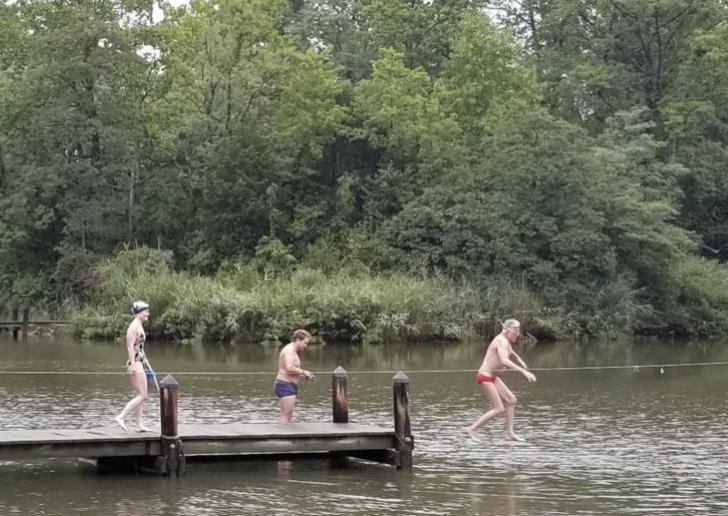“Is it safe to swim in the river?” is one of the most common questions ShoreRivers hears from community members. Fecal bacteria and toxic algae in waterways pose threats to both water quality and public health. People and pets who come in contact with bacteria- or toxin-laden water can contract eye, ear, and respiratory diseases; skin rashes; gastrointestinal issues; or brain or liver damage. To assess the health of our rivers and potential risks to human health, ShoreRivers’ Riverkeepers, with help from a dedicated team of volunteers, regularly monitor bacteria pollution at 34 sites throughout the middle and upper Eastern Shore.
The SwimmableShoreRivers program tests all the rivers in the ShoreRivers region for bacteria, primarily at public access locations, as well as at some marinas, yacht clubs, and town fishing piers. ShoreRivers conducts tests on a weekly basis from Memorial Day through Labor Day, and results are posted each Friday. Community members are encouraged to view the results at theswimguide.org and get updates during swim season by following the ShoreRivers and Riverkeeper pages on Facebook and Instagram. The program follows Environmental Protection Agency (EPA)’s standard protocols for collecting and analyzing samples and uses a pass/fail system to determine if bacteria levels are safe or unsafe for swimming.
ShoreRivers relies on dedicated volunteers to support their water quality testing programs. These “SwimTesters” are assigned sites and, after completing a training session, collect and deliver water samples to the ShoreRivers offices in Galena, Chestertown, and Easton. Additionally, ShoreRivers is grateful to its test site sponsors: Sailwinds Park Inc., On-site Septic Services, Caroline County Recreation and Parks, Chesapeake Designs, City of Cambridge, Town of Oxford, Corsica River Yacht Club, Kentmore Park Community, the McGunigle family, the Ruhl/Carski family, and Noa Stein, for her Bat Mitzvah project. At $600 per site, per season, contact your local Riverkeeper to learn more about sites in need of a sponsor.
The results from ShoreRivers’ monitoring in 2020 show that bacterial and algal conditions vary based on location, weather, and other factors, making systematic, scientific analysis vital. The good news is the majority of the bacteria monitoring sites passed more than 60% of the time. A few sites, however, passed less than 60% of the time, failing to meet EPA’s threshold for safe water contact. Specifically, these sites are located at Hambrooks Bay Beach, Crouse Park, Denton, Broad Cove Claiborne, and Morgan Creek Landing.
Now that the program has baseline data showing which sites frequently have elevated levels of bacteria, ShoreRivers will focus on the next most frequently asked question from the public: “Where does bacteria pollution come from at each site?” ShoreRivers is exploring partnerships and innovative technologies to help identify specific sources of bacteria pollution at specific testing locations.
“Once we know where the bacteria is coming from—whether it’s leaking sewer lines, failing septic systems, over-application of fertilizer, or people not picking up after their pets—we can start implementing real solutions,” says Choptank Riverkeeper Matt Pluta. “Monitoring techniques such as eDNA sampling and bacteria source tracking are improving and becoming more reliable. It’s another tool in our Riverkeeper toolbelt to help improve water quality conditions so Eastern Shore waterways are always safe and swimmable.”
The SwimmableShoreRivers program also works with government health agencies at local and state levels to monitor toxic algal blooms and inform the public of serious potential health risks to humans and pets. Algal blooms occur naturally, but increased levels of nutrient pollution in our waterways from fertilizers, septic systems, and wastewater plants fuel larger, more toxic, and longer-lasting blooms.
In our region, toxic blooms occur most frequently on the Sassafras River, due to its lower salinity levels. Last summer, a toxic algal bloom on the Sassafras lasted for almost three months. This was the largest, longest lasting, and most toxic bloom ever recorded on the river, causing the Maryland Department of the Environment to issue a water contact advisory for the whole river.
Already in 2021, small blooms have been identified in tributaries of the Sassafras. Sassafras Riverkeeper Zack Kelleher has responded to and tested these blooms with the help of Maryland’s Department of Natural Resources, and will continue to monitor the water weekly as the summer progresses. For more info on Sassafras algal blooms this summer, contact [email protected].
Annie Richards is the Chester Riverkeeper for ShoreRivers



Write a Letter to the Editor on this Article
We encourage readers to offer their point of view on this article by submitting the following form. Editing is sometimes necessary and is done at the discretion of the editorial staff.